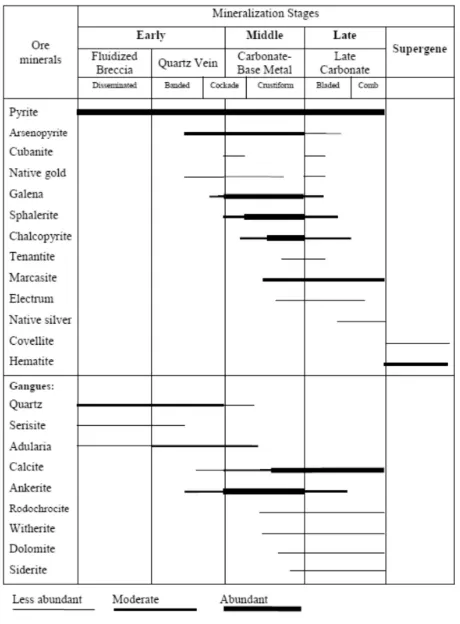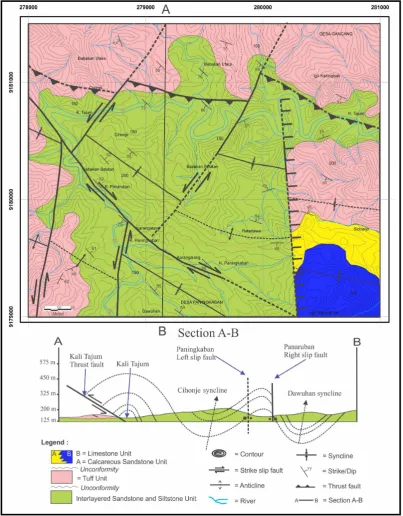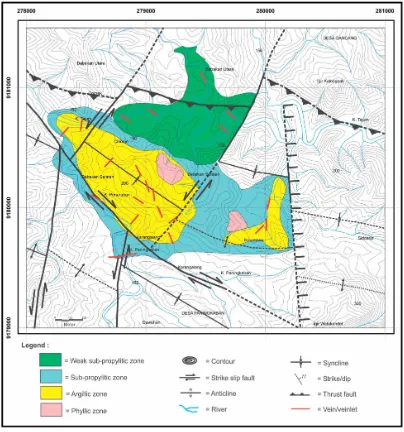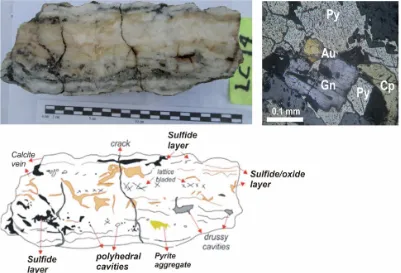GEOLOGY AND ORE MINERALISATION OF
NEOGENE SEDIMENTARY ROCK HOSTED LS
EPITHERMAL GOLD DEPOSIT AT
PANINGKABAN, BANYUMAS REGENCY,
CENTRAL JAVA, INDONESIA
Arifudin Idrus*1, Fahmi Hakim1, I Wayan Warmada1, Mochammad Aziz2, Jochen Kolb3, and F. Michael Meyer4
1Department of Geological Engineering, Gadjah Mada University, Yogyakarta, Indonesia 2Department of Geological Engineering, Jenderal Soedirman University, Indonesia 3Geological Survey of Denmark & Greenland
4RWTH Aachen University, Germany
Abstract
Low suphidation (LS) epithermal gold deposits were recently found in the Paningkaban area, Central Java province, Indonesia, with more than five hun-dred artisanal gold miners currently operating in the area. This study is aimed to understand the ge-ological factors controlling the gold mineralization and to characterize the alteration and ore mineral-ogy of the deposit. Several epithermal veins/veinlets trending N–S, NW–SE, and NE–SW are hosted by Tertiary turbiditic volcanoclastic sedimentary rocks of the Halang formation. This formation is com-posed of looping gradation of sandstone and silt-stone units. Pre- and syn-mineralization struc-tures such as extension joints, normal sinitral fault and sinitral fault control the gold mineralization. Fault movements formed dilational jogs manifested by NW-SE-trending en-echelon tension gash veins. Four main alteration zones are identified: (a) phyl-lic, (b) argilphyl-lic, (c) propylitic and (d) weak sub-propylitic. Ore minerals consist of native gold, elec-trum, native silver, pyrite, chalcopyrite, sphalerite, galena, arsenopyrite, cubanite, marcasite, covellite and tennantite, which are commonly associated with
*Corresponding author: A. IDRUS, Department of
Ge-ological Engineering, Gadjah Mada University. Jl. Grafika 2 Yogyakarta, Indonesia. E-mail: arifidrus@ugm.ac.id
argillic alteration. Vein structures such as massive, swarm and low angle veins, stockwork and veins dispersed in diatreme breccia are present. Normal banded, cockade, crustiform, bladed carbonates as well as, comb and saccharoidal features are the typi-cal vein textures. It is noteworthy that the veins are basically composed of carbonate with minor quartz at gold grades of up to 83 g/t Au. Based on the vein structures and textures, four stages of ore min-eralization were developed consisting of (a) early stage (fluidized breccia and quartz vein), (b) middle stage (carbonate-base metal), (c) late stage (late car-bonate), and supergene stage. Gold mineralization originated mainly during middle and late stages, particularly in association with cockade, crustiform, bladed carbonate-base metal veins. Based on those various features, the LS epithermal deposit in the study area is categorized as carbonate-base metal-gold mineralization type.
Keywords: Geology, Ore mineralization, Hy-drothermal alteration, LS epithermal, Paningkaban area, Indonesia.
1 Introduction
through Flores to its terminus in the Banda Islands (Banda arc). One of the most mineral-ized segments of the Sunda-Banda magmatic arc is the southern part of Java Island. Our research location, Paningkaban, is one of the gold-mineralized regions situated in Central Java, 165 km west of Yogyakarta (Figure 1).
Several primary gold and base metal de-posits were discovered along the Sunda-Banda magmatic arc, for instance, Kapur-Natas in North Sumatera (Idrus et al., 2007), Gunung Pongkor in West Java (Warmada, 2003), Selo-giri in WonoSelo-giri (Imaiet al., 2007) and Batu Hi-jau in Sumbawa (Garwin, 2000). All gold-base metal deposits described above are hosted by volcanic rocks. Gold exploration activities in Indonesia are recently not only focused on vol-canic/magmatic belt, but also starting to shift along metamorphic and sedimentary terrains. Primary gold mineralization occurring in as-sociation with metamorphic rocks are, for in-stance, Awak Mas in South Sulawesi (Queru-bin and Walters, 2011) and Gunung Butak in Buru Island, Mollucas (Idruset al., 2014). How-ever, no advanced studies have been conducted for hypogene gold deposits, particularly LS ep-ithermal gold vein types hosted by sedimentary rocks such as in the Paningkaban area.
2 Research methods
This study is conducted in four stages includ-ing literature, fieldwork, laboratory work, data processing and interpretation. Fieldwork in-cludes mapping of surface geology, alteration and ore mineralization as well as sampling of representative rock types, altered rocks and
3 Results and Discussion
Geology
The study area is underlain by a series of sedi-mentary units, which from oldest to youngest are interlayered sandstone and siltstone, tuff, calcareous sandstone, and limestone (Figure 2). The interlayered sandstone and siltstone unit is the host rock of LS epithermal gold mineraliza-tion in the study area. This unit is a member of the Miocene Halang formation. The feldspar-rich rock unit is weakly to intensely altered from subpropylitic to argillic alteration styles. The age of the volcano-sedimentary rock unit is Late Miocene (Djuri et al., 1996). Younger rock units are not mineralized and not altered. Pre- and syn-mineralization structures such as extension joints, normal-sinitral fault and sini-tral fault controlled the gold mineralization and alteration. Fault movements formed dilational jogs manifested by N–S, NE–SW and NW–SE-trending en-echelon tension gash veins (Figure 3).
Hydrothermal alteration
Figure 1: Research location (Paningkaban area) plotted on the SRTM (Shuttle Radar Topography Mission) map of Java Island.
closely associated with argillic and weak sub-propylitic alteration (Figure 4).
Ore mineralization
Vein structures such as massive, swarm and low angle veins, stockworks and diatreme breccia-hosted veins are present. Normal banded, cockade, crustiform, bladed carbon-ate, comb and saccharoidal are the typical open space filling textures of the LS epithermal veins. It is noteworthy that the veins are composed of carbonate with minor quartz and adularia and gold grades ranging from 0.09 to 83 g/t Au (8 vein samples). Electrum chemistry shows 73.9 wt.% Au and 23.5 wt.% Ag, respectively.
Based on the vein structures and textures, four stages of ore mineralization in the study area were developed consisting of: (a) early stage (fluidized breccia and quartz vein), (b) middle stage (carbonate-base metal), (c) late stage (late carbonate), and supergene stage (Ta-ble 1). Gold mineralization chiefly occurred during Middle and Late stages particularly in association with cockade, crustiform, bladed carbonate-base metal veins (Table 1 and Fig-ure 5). Less abundant electrum is also identi-fied within banded quartz veins from the early stage.
Precious metals identified consist of native gold, electrum and native silver (Figure 5), sul-phides consist of pyrite, chalcopyrite, spha-lerite, galena, arsenopyrite, cubanite, marcasite, covellite and tennantite. Gold-bearing veins are
Figure 3: NW–SE-trending en-echelon tension gash veins hosted by sandstone of Miocene Halang formation.
Figure 5: Photograph of a crustiform-bladed carbonate vein (top left) with related sketch (bottom), photomicrograph of ore sample showing the presence of native gold (Au) and base metal sulphides in the vein (top right).
commonly associated with argillic and weak sub-propylitic alteration types (Figure 4). It is obvious that the epithermal veins are pre-dominantly composed of gold and base metal sulphides in association with carbonate (calcite and ankerite) and minor quartz as gangue min-erals.
Implication for exploration
The Paningkaban LS epithermal gold veins hosted by interlayered sandstone-siltstone unit of the Miocene Halang formation is the only known gold deposit, which is mined by small-scale miners in the region. Lithologic control and extensional structural deformation form-ing dilational jogs are the important geological factors for the formation of gold mineralized N–S, NE–SW and NW–SE-trending en-echelon tension gash veins. A careful study on the deposit geology, hydrothermal alteration, and ore characterization is crucial for an economic evaluation of the deposit since resulted maps
and ore deposit characteristics are needed for designing an effective exploration program and a positive cost-benefit result of this gold deposit type as a new primary gold resources in Indonesia.
4 Conclusion
Two important geological factors controlling the formation of the LS epithermal gold veins at Paningkaban area. These are the specific lithological make up (i.e., interlayered sand-stone and siltsand-stone) as well as pre- and syn-mineralization extensional and transtensional structures. Transtensional fault movements caused dilational jogs manifested by N–S, NE– SW and NW–SE-trending gold mineralized en-echelon tension gash veins.
that the gold deposit occurring in the study area is a carbonate-base metal gold mineraliza-tion sub-type of a LS epithermal system. The Tertiary sedimentary rocks that host this gold mineralization could be a new target for gold exploration in the future in Indonesia, particu-larly in the regions that are of similar geologic evolution and structural setting.
Acknowledgements
This study was funded by DIKTI International Research Collaboration and Scientific Publica-tion (KLN) research grant 2015/2016 awarded to the first author. Fieldwork was partly sup-ported by Blacksmith project in collaboration with GEUS (Geological Survey of Denmark and Greenland). EPMA analysis was done by Su-tarto and Roman Klinghardt at IML RWTH Aachen University. Their support is thankfully appreciated.
References
Carlile, J.C. and Mitchell, A.H.G (1994) Mag-matic arcs and associated gold and copper mineralisation in Indonesia: in van Leeuwen, T.M., Hedenquist, J.W., James, L.P., and Dow, J.A.S., eds., Mineral Deposits of Indonesia, Discoveries of the Past 25 Years: Journal of Geochemical Exploration, v. 50, pp. 91-142. Corbett, G.J. (2004) Epithermal and porphyry
gold – geological models. Proceedings PACRIM Congress 2004, Adelaide. pp. 15-23. Djuri, M., Samodra, H., Amin T.C. and Gafoer, S. (1996) Geological Map Sheet of Purwokerto-Tegal, scale 1:100.000. Centre
of Geological Research and Development, Bandung.
Garwin, S.L. (2000) The setting, geometry and timing of intrusion-related hydrothermal sys-tems in the vicinity of the Batu Hijau por-phyry copper-gold deposit, Sumbawa, In-donesia: Unpublished Ph.D. Thesis, Univer-sity of Western Australia, Perth, 320 p. Idrus, A., Pulungan, B.A.A. and Titisari, A.D.
(2007) Geology, hydrothermal alteration and mineralization of the Kapur-Natas epither-mal low sulphidation, South Tapanuli dis-trict, North Sumatra – Indonesia, Prosiding PIT IAGI, Bali, November 2007, pp. 1 – 11. Idrus, A., Prihatmoko, S., Hartono, H.G.,
Fadlin, Ernowo, Franklin, Moetamar and Setiawan, I. (2014) Some key features and possible origin of the metamorphic rock-hosted gold mineralization in Buru island, Indonesia, Indonesian Journal on Geoscience, 1: 9-19.
Imai, A., Shinomiya, J., Soe, M.T., Setijadji, L.D., Watanabe, K., Yoshikawa, R. and Warmada, IW. (2007) Porphyry-type mineralization at Selogiri area, Wonogiri regency, Central Java, Indonesia. Resource Geology 57: 130-140. Querubin, C.D., and Walters, S. (2011)
Geol-ogy and Mineralization of Awak Mas: A Sedimentary Hosted Gold Deposit, South Sulawesi, Indonesia, Proceedings of The Sulawesi Mineral Seminar, Manado 28-29 November 2011, pp. 211-229.



